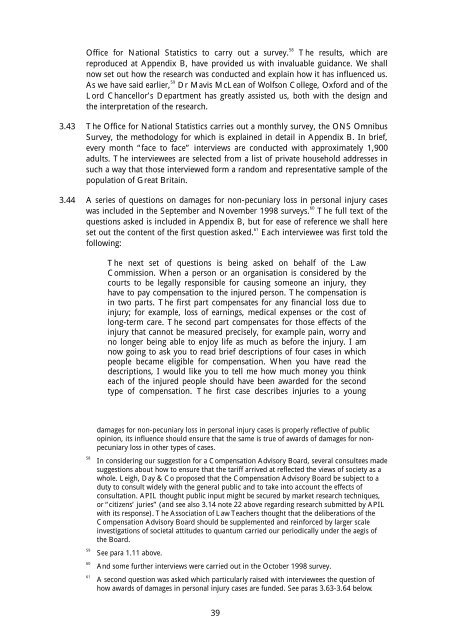damages for personal injury: non-pecuniary loss - Law Commission
damages for personal injury: non-pecuniary loss - Law Commission
damages for personal injury: non-pecuniary loss - Law Commission
You also want an ePaper? Increase the reach of your titles
YUMPU automatically turns print PDFs into web optimized ePapers that Google loves.
Office <strong>for</strong> National Statistics to carry out a survey. 58<br />
The results, which are<br />
reproduced at Appendix B, have provided us with invaluable guidance. We shall<br />
now set out how the research was conducted and explain how it has influenced us.<br />
As we have said earlier, 59<br />
Dr Mavis McLean of Wolfson College, Ox<strong>for</strong>d and of the<br />
Lord Chancellor’s Department has greatly assisted us, both with the design and<br />
the interpretation of the research.<br />
3.43 The Office <strong>for</strong> National Statistics carries out a monthly survey, the ONS Omnibus<br />
Survey, the methodology <strong>for</strong> which is explained in detail in Appendix B. In brief,<br />
every month “face to face” interviews are conducted with approximately 1,900<br />
adults. The interviewees are selected from a list of private household addresses in<br />
such a way that those interviewed <strong>for</strong>m a random and representative sample of the<br />
population of Great Britain.<br />
3.44 A series of questions on <strong>damages</strong> <strong>for</strong> <strong>non</strong>-<strong>pecuniary</strong> <strong>loss</strong> in <strong>personal</strong> <strong>injury</strong> cases<br />
was included in the September and November 1998 surveys. 60<br />
The full text of the<br />
questions asked is included in Appendix B, but <strong>for</strong> ease of reference we shall here<br />
set out the content of the first question asked. 61<br />
Each interviewee was first told the<br />
following:<br />
The next set of questions is being asked on behalf of the <strong>Law</strong><br />
<strong>Commission</strong>. When a person or an organisation is considered by the<br />
courts to be legally responsible <strong>for</strong> causing someone an <strong>injury</strong>, they<br />
have to pay compensation to the injured person. The compensation is<br />
in two parts. The first part compensates <strong>for</strong> any financial <strong>loss</strong> due to<br />
<strong>injury</strong>; <strong>for</strong> example, <strong>loss</strong> of earnings, medical expenses or the cost of<br />
long-term care. The second part compensates <strong>for</strong> those effects of the<br />
<strong>injury</strong> that cannot be measured precisely, <strong>for</strong> example pain, worry and<br />
no longer being able to enjoy life as much as be<strong>for</strong>e the <strong>injury</strong>. I am<br />
now going to ask you to read brief descriptions of four cases in which<br />
people became eligible <strong>for</strong> compensation. When you have read the<br />
descriptions, I would like you to tell me how much money you think<br />
each of the injured people should have been awarded <strong>for</strong> the second<br />
type of compensation. The first case describes injuries to a young<br />
<strong>damages</strong> <strong>for</strong> <strong>non</strong>-<strong>pecuniary</strong> <strong>loss</strong> in <strong>personal</strong> <strong>injury</strong> cases is properly reflective of public<br />
opinion, its influence should ensure that the same is true of awards of <strong>damages</strong> <strong>for</strong> <strong>non</strong><strong>pecuniary</strong><br />
<strong>loss</strong> in other types of cases.<br />
58 In considering our suggestion <strong>for</strong> a Compensation Advisory Board, several consultees made<br />
suggestions about how to ensure that the tariff arrived at reflected the views of society as a<br />
whole. Leigh, Day & Co proposed that the Compensation Advisory Board be subject to a<br />
duty to consult widely with the general public and to take into account the effects of<br />
consultation. APIL thought public input might be secured by market research techniques,<br />
or “citizens’ juries” (and see also 3.14 note 22 above regarding research submitted by APIL<br />
with its response). The Association of <strong>Law</strong> Teachers thought that the deliberations of the<br />
Compensation Advisory Board should be supplemented and rein<strong>for</strong>ced by larger scale<br />
investigations of societal attitudes to quantum carried our periodically under the aegis of<br />
the Board.<br />
59 See para 1.11 above.<br />
60 And some further interviews were carried out in the October 1998 survey.<br />
61 A second question was asked which particularly raised with interviewees the question of<br />
how awards of <strong>damages</strong> in <strong>personal</strong> <strong>injury</strong> cases are funded. See paras 3.63-3.64 below.<br />
39

















